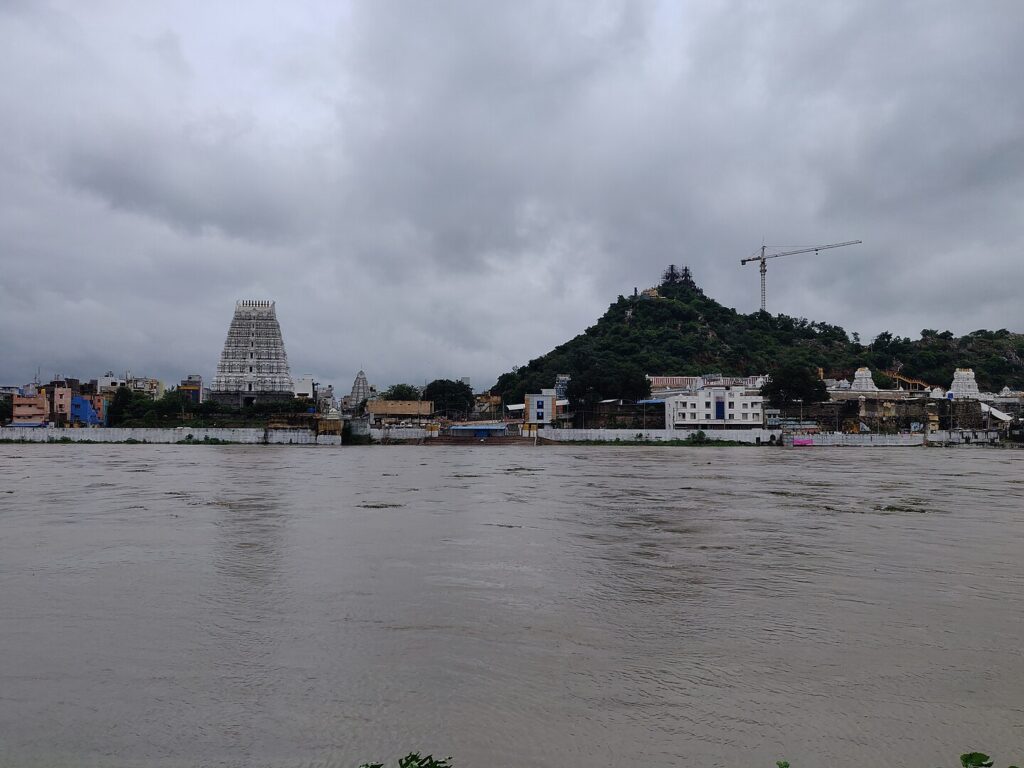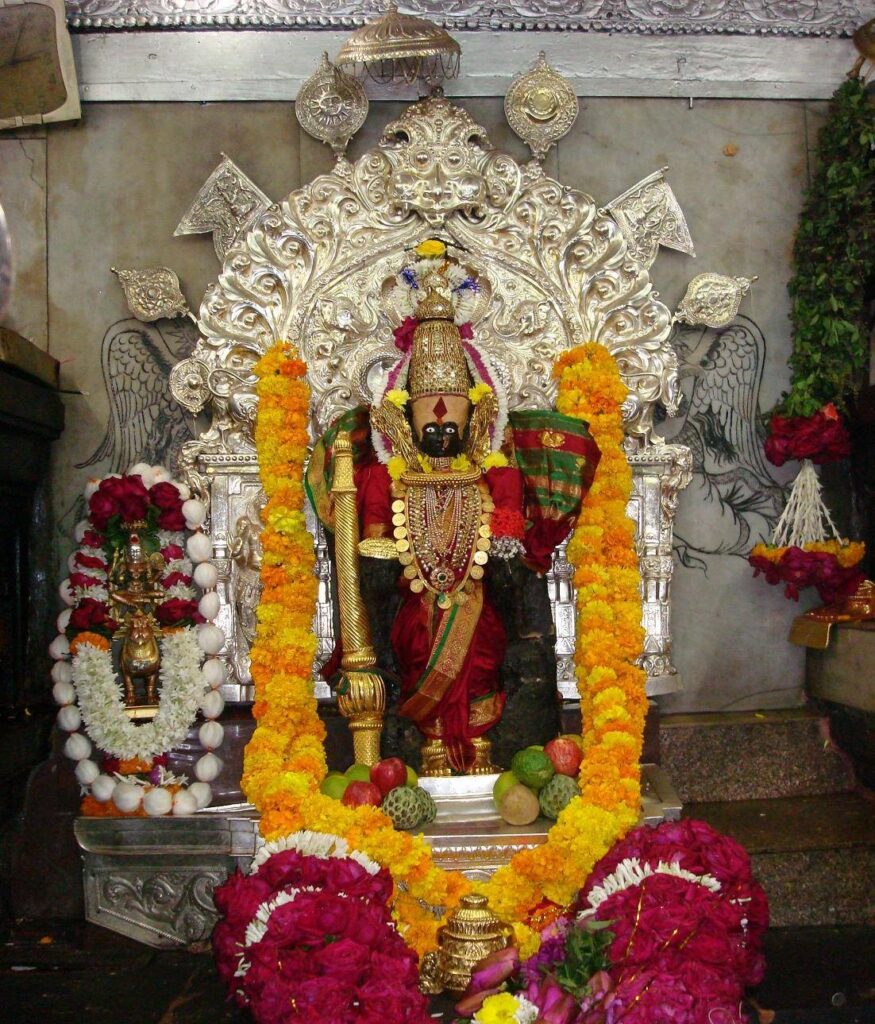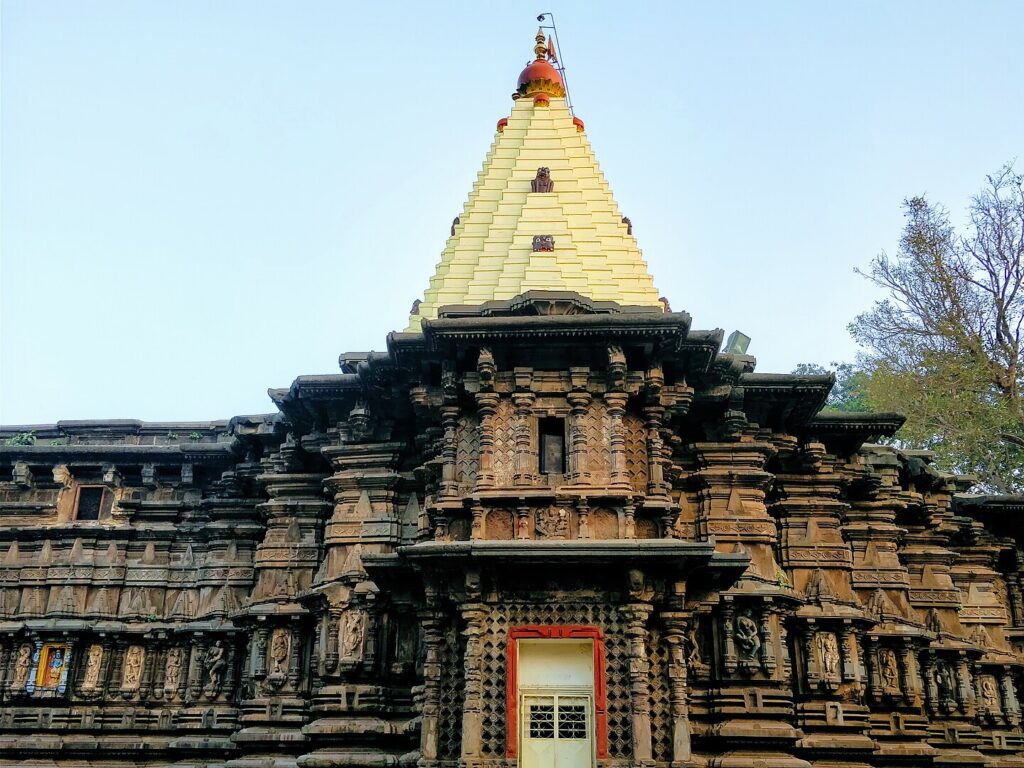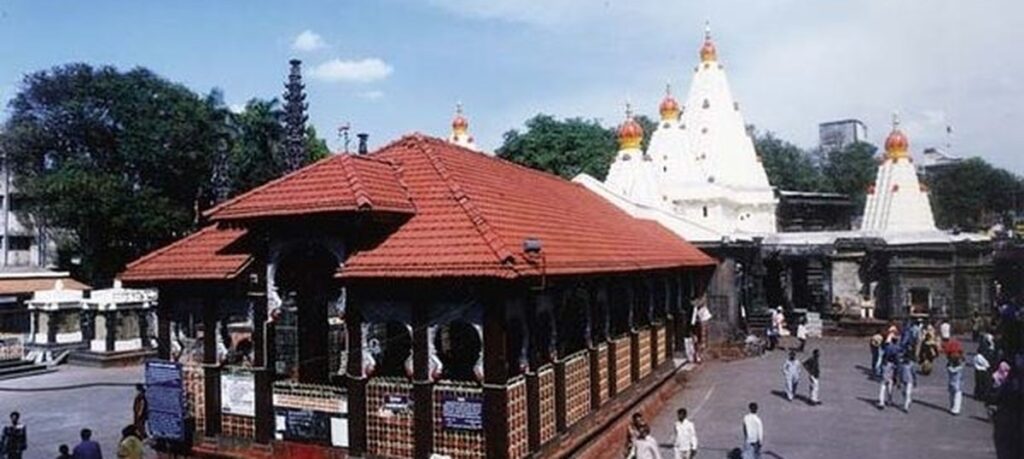Sri Mahalakshmi Temple, Kolhapur
Sri Mahalakshmi is the consort of Mahavishnu. The divine couple’s dwelling place is Vaikunta. Sri Mahalakshmi accompanied Sri Mahavishnu in most of his incarnations.
Tirumala Venkateswara is one of the incarnations of ‘Lord Vishnu’ and so Tirumala Venkateswara is also invoked with the name ‘Srinivasa’ in which ‘Sri’ means Mahalakshmi and ‘Nivasa’ means ‘abode’, – ‘the abode of Mahalakshmi’ .
Daughter of the Ocean of Milk,
Glow of heavenly bodies,
Abode of fortune,
Beloved of Sri Mahavishnu,
Goddess of Wealth – Sri Mahalakshmi
Sri Mahalakshmi is the domicile of fortune. Deeply hurt by the placid behavior of Mahavishnu towards Sage Bhrigu who visited Vaikunta to test Mahavishnu, Mahalakshmi left Vaikunta and settled on earth in the ancient city of Kolhapur.

Kolhasura and Karaveera
Kolhasura and Karaveera, the two giants, were rulers of Kolhapura. Goddess Lakshmi did a ferocious war and executed the two giants. From then onwards, Kolhapur has been considered as the most significant place, and Goddess Lakshmi is worshipped as Kolhapuravasini and Karaveerapuranivasini.
After it, Mahavishnu, in search of Mahalakshmi reached earth and settled at Venkatachala on the name of Venkateswara. Lord Venkateswara did penance for ten years at Kolhapuram to get back Sri Mahalakshmi but failed to convince her.
12 years of penance
On the suggestion of Asariravani, Sri Venkateswara Swami performed 12 years of penance on the bank of the Swarnamukhi River at Padmasarovaram. Pleased with Sri Vishnu’s penance, Mahalakshmi appeared in Padmasaravoram as Alamelmangamma and Padmavathi in the golden flower which contains 1000 petals and restored the fortune of heaven to Venkateswara.

Legend: The Story of Mahalakshmi
According to the legend, Sri Mahalakshmi, the consort of Mahavishnu felt insulted and left Vaikunta in anger and settled down in Kolhapur. Then the eminent Agastya accompanied with his peer members, reached Kolhapur to see Mahalakshmi.
They recited the Goddess with innumerable names like
- Padmavathipuramani,
- Yakshalayamani,
- Shivalayamani,
- Dakshina kasimani (The place where Sathidevi eyes fell during Daksha Yagna),
Karaveerapuramani also invoked her with different slokas.
Delighted with their hymns, Mahalakshmi blessed them that she would stay in Karaveerapuram, blessing the people on earth.
How the names Kolhapuram and Karaveerapuram did come into use?
Lord Brahma created Gayasura, Lavanasura, and Kolhasura on earth. The three were born in the zodiac sign of monsters and as they grow, their behavior and attitude turn cruel and violent. They harassed people and sages. Unable to tolerate their attitude, Lord Vishnu killed Gayasura and Lavanasura. Kolhasura was the only one who survived among the three.
He developed an attitude of revenge on Sri Vishnu who slaughtered his brothers. He realized that he could kill Vishnu only after attaining the power that he could gain from severe penance. Leaving his responsibilities to his son, Kolhasura went for penance.
Immediately after he left, Sukesi, the enemy of Kolhasura, killed his two sons and seized Kolhapura. He tortured the Gods and sages and made them think that Kolhasura was better than Sukesi. They waited for the day of Kolhasura’s return. After a few decades, Kolhasura returned to his kingdom. He was shocked to hear the assault of Sukesi on his kingdom.
With anger, he killed Sukesi, his sons, relatives and regained his throne. Even then, the revenging attitude on Gods and sages did not die. He tried to kill them but he couldn’t. He was disappointed and searched for reasons. He traced out the mystery behind it.
Kolhasura – Penance – Asking Goddess to leave Padmavathipuram
Kolhasura sensed that Sri Mahalakshmi, the Goddess of heavenly bodies resided at Padmavathipuram in Kolhapur. He understood the reason behind his continuous failures. He decided that he should keep aloof Mahalakshmi from Gods and that he could achieve only through penance.
He assigned his responsibilities to his son Karaveera and reached the forest. He did deep meditation to impress Mahalakshmi. Satisfied with his Prayers, Sri Mahalakshmi appeared before him and asked him to convey his desire. He requested Goddess Lakshmi to leave Padmavathipuram for 100 years.
Blessing Kolhasura, Goddess left his kingdom. But by the time he returned to his place, he almost crossed his age and so he handed over his responsibilities to his son Karaveera. Karaveera was more cruel than Kolhasura and tortured Gods. Trembled by his behavior, Lord Shiva put Karaveera to death. While he was dying, he requested Lord Shiva to bless him so that his place should be called in his name.
From then onwards, the place has been called Karaveerapuram.
After Karaveera’s Death
On hearing the death of Karaveera, his father Kolhasura raged and started harassing the Gods. On request, Goddess Lakshmi answered the Gods that no one could kill him for 100 years and so suggested them to wait for time. Once the time given was crossed, Sri Mahalakshmi killed Kolhasura.
While he was dying, he requested Mahalakshmi to bless the place as the holy shrine and it should be called in his name. From then onwards, the place was denoted as Kolhapuram and Sri Mahalakshmi settled in that place blessing her devotees.
Sri Mahalakshmi
The temple is highly known for its artistic sculpture. In the temple’s sanctum Sanctorum, Goddess Lakshmi is placed on a two-foot seat, carved on a six square feet pedestal.

The deity is in a sitting posture, holding the objects of symbolic value in her four hands.
- The first holds a citrus fruit,
- the second-hand holds a large mace,
- the third holds a shield and
- the last has a bowl.
The image of Mahalakshmi is three feet, embellished with jewels and gems. A stone lion statue stands behind the statue of the Goddess. Unlike the other statues, this statue faces west. The light of the setting sun touches the face of the image through a small open window, three times a day, for three consecutive days, two or three times a year.
The devotees of Mahalakshmi specifically visit more in numbers during those three successive days to see the wonder of the temple. Sri Chakra is placed over the sanctum Sanctorum. The existence of the Mahalakshmi temple goes back to the very early centuries.
Later in the 11th century, during the time of Gandaraditya, the area of the temple extended. Mahakali and Mahasaraswathi temples were built along with the path to circumambulation around the temple. Sriyantra was placed between the main deity of the temple and the statue of Mahakali.
The Architectural beauty of the temple
Of all the temples of Mahalakshmi, the temple of Kolhapur is the most famous and significant temple. It is located in Maharashtra on the bank of the Panchaganga river. Its history goes back to 6000 years. The kings of different dynasties were involved in building this temple. This temple was built in a spacious place.
It displays Hemandpanthi’s architectural form with beautiful sculpture. The temple has four archways in four directions with five domes. One dome is in the centre and the other four domes lie in four directions North, South, East, and West.
Under the dome on the east lies the sanctum of Mahalakshmi with Kumaramandap under the center dome, West – Ganapathi, North – Mahakali, and South – Mahasaraswathi. Inside the temple premises, various shrines of Gods and Goddess consecrated namely Venkateswara, Radha Krishna, Kalabhairava, Vinayaka, Simhavahini, Tulja bhavani and many more along with Navagrahas.

What does Devi Mahatyam speak about?
Mahalakshmi appears in nine different forms: Mahishasuramardhani, yogindra (Mahakali), Kaushika (Maha Vidya), Sunandha (Vindhyavasini), Raktadhamtika, Shakambari (Daanya Lakshmi), Durga, Bhima, Bhramari.
Sri Mahalakshmi Srinivasa
Sri Mahalakshmi is the beloved of Mahavishnu. She is an embodiment of virtuousness and righteousness, pervaded all over Mahavishnu who is an embodiment of the universe. She spread through in every part of Mahavishnu as eight Lakshmi’s –
- The eternal body – Bhagya Lakshmi,
- two hands – Daanya Lakshmi,
- Two shoulders – Veera Lakshmi,
- heart – Bhootha Kaarunya Lakshmi,
- virtuousness – Keerthi Lakshmi,
- placid nature – Sowmya Lakshmi,
- Nandaka kadgam – Sourya Lakshmi and
- the whole structure – Sarva Samrajya Lakshmi.
Due to being spread through the body of Vishnu, Swamy is also named ‘Sri Mahalakshmi Srinivasa’.
Rituals and Prayers
Worship services are offered every day five times starting with the Suprabhata service (Opening of the temple). The Kakada Aarti is (the morning aarti) followed by Morning Mahapuja at 8.00 AM. Thereafter, the afternoon Aarti along with other services; the temple closes with Shej Aarti (the Night Aarti).
Every Friday, special and specific prayers are offered to Goddess Lakshmi. The Full Moon day of Chaitra month and the Dasara festival are splendidly celebrated. A festival image of the deity is taken out on procession around the temple courtyard on Full Moon Days.

How to Reach Kolhapur
Road and rail transport facilities to Kolhapur are frequent from Hyderabad which is about 540 km distance. Mahalakshmi also appeared as Padmavathi at Tiruchanur. The Goddess Mahalakshmi at Kolhapur and Padmavathi at Tiruchanur are known as the Goddesses who shower their love and blessings on those who dedicate themselves wholeheartedly.
So let’s visit these temples to seek their blessings and to overcome all hurdles and obstacles in life.
Click here for the official website

